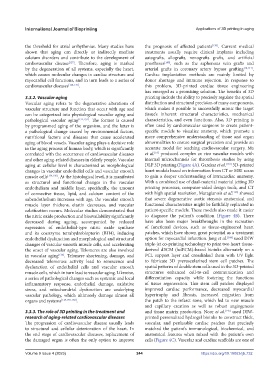Page 252 - IJB-9-4
P. 252
International Journal of Bioprinting Applications of 3D printing in aging
the threshold for atrial arrhythmias. Many studies have the prognosis of affected patients [139] . Current medical
shown that aging can directly or indirectly mediate treatments usually require clinical implants including
calcium disorders and contribute to the development of autografts, allografts, xenografts grafts, and artificial
cardiovascular disease [127] . Therefore, aging is marked prostheses [140] , such as the saphenous vein grafts and
by the degeneration of all systems, especially the heart, arterial grafts in coronary artery bypass grafting [18,141] .
which causes molecular changes in cardiac structure and Cardiac implantation methods are mainly limited by
myocardial cell functions, and in turn leads to a series of donor shortage and immune rejection. In response to
cardiovascular diseases [128-131] . this problem, 3D-printed cardiac tissue engineering
has emerged as a promising solution. The benefits of 3D
3.3.2. Vascular aging printing include the ability to precisely regulate the spatial
Vascular aging refers to the degenerative alterations of distribution and structural precision of many components,
vascular structure and function that occur with age and which makes it possible to successfully mimic the target
can be categorized into physiological vascular aging and tissue’s inherent structural characteristics, mechanical
pathological vascular aging [132,133] . The former is caused characteristics, and even functions. Also, 3D printing is
by programmed aging of the organism, and the latter is often used by cardiovascular surgeons to create patient-
a pathological change caused by environmental factors, specific models to visualize anatomy, which promote a
nutritional factors and diseases that cause accelerated more comprehensive understanding of tissue and organ
aging of blood vessels. Vascular aging plays a decisive role abnormalities to ensure surgical precision and provide an
in the aging process of human body, which is significantly accurate model for teaching cardiovascular surgery. Ma
[18]
correlated with the occurrence of cardiovascular diseases et al. produced complex ex vivo vascular models with
and other aging-related diseases in elderly people. Vascular internal microchannels for thrombosis studies by using
aging at cellular level is characterized as morphological DLP 3D printing (Figure 4A). Garekar et al. [142] 3D-printed
changes in vascular endothelial cells and vascular smooth heart models based on information from CT or MRI scans
muscle cells [134,135] . At the histological level, it is manifested to gain a deeper understanding of intracardiac anatomy.
as structural and functional changes in the vascular With a combined use of dual-material material jetting 3D
endothelium and middle layer, specifically, the amount printing processes, computer-aided design tools, and CT
of connective tissue, lipid, and calcium content of the with high spatial resolution, Maragiannis et al. [143] showed
subendothelium increases with age, the vascular smooth that severe degenerative aortic stenosis anatomical and
muscle layer thickens, elastin decreases, and vascular functional characteristics might be faithfully replicated in
calcification occurs. Molecular studies demonstrated that patient-specific models. These models also made it easier
the nitric oxide production and bioavailability significantly to diagnose the patient’s condition (Figure 4B). There
decreased during ageing, accompanied by reduced have also been major breakthroughs in the recreation
expression of endothelial-type nitric oxide synthase of functional devices, such as tissue-engineered heart
and its coenzyme tetrahydrobiopterin (BH4), inducing patches, which have shown great potential as a treatment
endothelial dysfunction and morphological and structural option for myocardial infarction. Jang et al. [144] used DIW
changes of vascular smooth muscle cells, and accelerating triple-jet co-printing technology to print two heart tissue-
the onset of vascular aging. Telomeres are also involved derived dECM (hdECM)-based bioinks alternately on a
in vascular aging [136] . Telomere shortening, damage, and PCL support layer and crosslinked them with UV light
decreased telomerase activity lead to senescence and to fabricate 3D prevascularized stem cell patches. The
dysfunction of endothelial cells and vascular smooth spatial patterns of double stem cells used in the 3D-printed
muscle cells, which in turn lead to vascular aging. Likewise, structures enhanced cell-to-cell communication and
a series of pathological changes such as systemic and local differentiation capacity while fostering the functions
inflammatory response, endothelial damage, oxidative of tissue regeneration. This stem cell patches displayed
stress, and mitochondrial dysfunction are underlying improved cardiac performance, decreased myocardial
vascular pathology, which ultimately damage almost all hypertrophy and fibrosis, increased migration from
organs and systems [129,135-138] . the patch to the infarct zone, which led to new muscle
and capillary creation as well as robust angiogenesis
3.3.3. The role of 3D printing in the treatment and and tissue matrix production. Noor et al. [145] used DIW-
research of aging-related cardiovascular diseases printed personalized hydrogel bioinks to construct thick,
The progression of cardiovascular disease usually leads vascular, and perfusable cardiac patches that precisely
to structural and cellular deterioration of the heart. In matched the patient’s immunological, biochemical, and
the end stage of cardiovascular diseases, replacement of anatomical features when mixed with the patient’s own
the damaged organ is often the only option to improve cells (Figure 4C). Vascular and cardiac scaffolds are one of
Volume 9 Issue 4 (2023) 244 https://doi.org/10.18063/ijb.732

